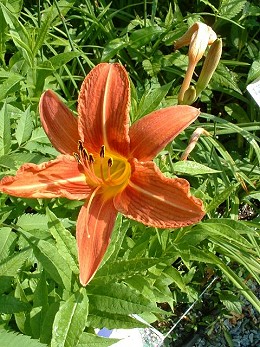
|
|
Daylily (Hemerocallis
fulva)
|
Daylily
- Hemerocallis spp.
This group consists of 15 species (as well as numerous
hybrids) of deciduous or evergreen, perennial plants commonly known as Daylilies.
They belong in the family Hemerocallidaceae. Despite the name they are not true lilies
(Lilium, Liliaceae).
Their Lily-like flowers usually last only a day, thus the common name, Daylily, but are borne in succession over a period of two to six weeks during the
summer.
Daylilies are natives of Japan and other eastern countries and southern
Europe; some kinds are naturalized in North America. Daylilies range in height from compact
plants, 12 to 15 inches high, to large plants up to 5 feet. They have long,
slender, arching leaves, 1 to 2 feet in length. Their flower clusters are held above the leaves on long
stems. Some hybrids produce up to 50 buds on each flower stalk. The flower colors of the species come in vibrant shades of
yellow, orange, and red, with a much more varied color selection in the hybrids.
Plants have been developed with flowers in cream,
gold, scarlet, pink, apricot, purple, violet, and plum, as well as bicolor combinations with banded or streaked
petals. Some flowers are fragrant and some have ruffled petals. There are also
hybrids, which repeatedly bloom throughout the summer; they bloom early, then after a short
rest, bloom again, constantly repeating the process.
We may think of the daylily as a modern or new flower since it is not until the early 1930s that Arlow Burdette Stout initiated a new era of research on
Hemerocallis. This brought about a natural break in the history of the daylily and resulted in many scientists and amateurs becoming involved in the hybridizing of
daylilies.
The use of the daylily by ancient Chinese people began before the development of written
language. The earliest records report the plants use for food. The flower buds were
palatable, digestible, and nutritious. As a medicine the root and crown were found to be a good pain
reliever. The utilization of the daylily for food and medicine became a part of the tradition of the Chinese
people.
In one section of China, the primary effect of the daylily on the people was emotional - an antidote for
grief. The bright flower is cheerful and uplifting to the spirit. One book of medicine compiled in the Sung Dynasty
(about A.D. 1059) says, “The root of the daylily is cooling and nonpoisonous. It is diuretic and is advised for curing incontinence and
dysuria. The juice extracted from fresh roots after pounding is administered internally to patients suffering from cirrhosis and
jaundice. Boiled young shoots are also advised.“ In this same treatise a special prescription is given for high fever and
hemorrhage.
Almost all the parts of Daylily are edible. Leaves and young shoots cooked. An asparagus or celery
substitute. An excellent sweet tasting vegetable, though some caution is
recommended. The leaves need to be eaten whilst still very young since they quickly become
fibrous.
Flowers
raw or cooked. The petals are thick and crunchy, making very pleasant eating raw, with a nice sweetness at the base because of the
nectar. The flowers can also be dried and used as a thickener in soups etc. In this
case, they are picked when somewhat withered and closed. A rich source of iron.
The flowers of some edible species are sold (fresh or dried) in Asian markets as golden needles
Flower buds raw or cooked. A pea-like flavour. Can be dried and used as a
relish. The dried flower contains about 9.3% protein. 25% fat!?, 60% carbohydrate
(rich in sugar), 0.9% ash. It is rich in vitamin
A. Tubers raw or cooked. A nutty flavour. Young tubers are best, though the central portion of older tubers is also
good.
From China the daylily was brought to Asia Minor, where as early as A.D. 70 the Greek herbalist Dioscorides referred to a form now called the Lemon or Custard Daylily
(H. Flava). This lovely, fragrant daylily is still grown and prized in gardens today for its
long-lasting light yellow blooms in early spring.
It was in 1753 that the daylily received its accepted generic name, when the great Swedish
naturalist, Linnaeus, published his Species Planatarum. At that time he also assigned the Lemon and Tawny Daylilies to the same
species.
Many species of the daylily have been found in China and Japan. They are rarely found in today’s
gardens, since the new hybrids have far surpassed them in beauty, but they were certainly
valuable, for they are the ancestors of our beautiful hybrids. Further explorations into Asia for new clones could prove valuable to breeders
today.
It was through the efforts of hybridizers in the United States and England that great improvements in the daylilies have taken place during the last 75
years. Originally the only colors were yellow, orange, and fulvous red, and today we have colors ranging from
near-whites, pastels, yellows, oranges, pinks, vivid reds, crimson, purple, nearly
true-blue and fabulous blends. The daylily from the wild is now the Cinderella in all its glorious colors and
forms.
Source:
http://www.botanyworld.com/hemerocallis.html
http://www.tesselaar.net.au/plantprofiles/daylilies.asp
http://www.pfaf.org/database/plants.php?Hemerocallis+fulva
